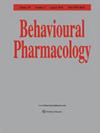Thymoquinone ameliorates symptoms of Parkinson's disease in a 6-OHDA rat model by downregulation of miR-204-3p.
IF 1.6
4区 心理学
Q3 BEHAVIORAL SCIENCES
引用次数: 0
Abstract
microRNAs (miRNAs) play a significant role in the pathophysiology of Parkinson's disease. In this study, we evaluated the neuroprotective effect of thymoquinone on the expression profiles of miRNA and cognitive functions in the 6-hydroxydopamine (6-OHDA)-induced Parkinson's model. Male adult Wistar albino rats (200-230 g, n = 36) were randomly assigned to six groups: Sham, thymoquinone (10 mg/kg, p.o.), 6-OHDA, 6-OHDA + thymoquinone (10 mg/kg), 6-OHDA + thymoquinone (20 mg/kg), and 6-OHDA + thymoquinone (50 mg/kg). Behavioral changes were detected using the open field and the elevated plus maze tests. The mature 728 miRNA expressions were evaluated by miRNA microarray (GeneChip miRNA 4.0). Ten miRNAs were selected (rno-miR-212-5p, rno-miR-146b-5p, rno-miR-150-5p, rno-miR-29b-2-5p, rno-miR-126a-3p, rno-miR-187-3p, rno-miR-34a-5p, rno-miR-181d-5p, rno-miR-204-3p, and rno-miR-30c-2-3p) and confirmed by real-time PCR. Striatum samples were stained with hematoxylin-eosin to determine the effect of dopaminergic lesions. One-way ANOVA test and independent sample t-test were used for statistical analyses. rno-miR-204-3p was upregulated at 6-OHDA and downregulated at the 50 mg/kg dose of thymoquinone. In conclusion, thymoquinone at a dose of 50 mg/kg ameliorates symptoms of Parkinson's disease in a 6-OHDA rat model by downregulation of miR-204-3p. Also, the results showed that thymoquinone can improve locomotor activity and willing exploration and decreased anxiety. Therefore, thymoquinone can be used as a therapeutic agent.胸腺醌通过下调 miR-204-3p 改善 6-OHDA 大鼠模型中帕金森病的症状。
微RNA(miRNA)在帕金森病的病理生理学中发挥着重要作用。本研究评估了胸腺醌对 6-羟基多巴胺(6-OHDA)诱导的帕金森病模型中 miRNA 表达谱和认知功能的神经保护作用。雄性成年 Wistar 白化大鼠(200-230 克,n = 36)被随机分为六组:Sham 组、胸腺醌(10 mg/kg,p.o.)组、6-OHDA 组、6-OHDA + 胸腺醌(10 mg/kg)组、6-OHDA + 胸腺醌(20 mg/kg)组和 6-OHDA + 胸腺醌(50 mg/kg)组。行为变化通过开阔地和高架加迷宫试验进行检测。通过 miRNA 微阵列(GeneChip miRNA 4.0)评估了成熟的 728 个 miRNA 表达。选取了 10 个 miRNA(rno-miR-212-5p、rno-miR-146b-5p、rno-miR-150-5p、rno-miR-29b-2-5p、rno-miR-126a-3p、rno-miR-187-3p、rno-miR-34a-5p、rno-miR-181d-5p、rno-miR-204-3p 和 rno-miR-30c-2-3p),并通过实时 PCR 进行了确认。纹状体样本经苏木精-伊红染色以确定多巴胺能病变的影响。rno-miR-204-3p在6-OHDA作用下上调,而在胸腺醌50 mg/kg剂量作用下下调。总之,胸腺醌 50 毫克/千克的剂量可通过下调 miR-204-3p 改善 6-OHDA 大鼠模型中帕金森病的症状。研究结果还显示,胸腺醌能改善大鼠的运动活动和探索意愿,并能降低焦虑。因此,胸腺醌可用作一种治疗药物。
本文章由计算机程序翻译,如有差异,请以英文原文为准。
求助全文
约1分钟内获得全文
求助全文
来源期刊

Behavioural Pharmacology
医学-行为科学
CiteScore
3.40
自引率
0.00%
发文量
84
审稿时长
6-12 weeks
期刊介绍:
Behavioural Pharmacology accepts original full and short research reports in diverse areas ranging from ethopharmacology to the pharmacology of schedule-controlled operant behaviour, provided that their primary focus is behavioural. Suitable topics include drug, chemical and hormonal effects on behaviour, the neurochemical mechanisms under-lying behaviour, and behavioural methods for the study of drug action. Both animal and human studies are welcome; however, studies reporting neurochemical data should have a predominantly behavioural focus, and human studies should not consist exclusively of clinical trials or case reports. Preference is given to studies that demonstrate and develop the potential of behavioural methods, and to papers reporting findings of direct relevance to clinical problems. Papers making a significant theoretical contribution are particularly welcome and, where possible and merited, space is made available for authors to explore fully the theoretical implications of their findings. Reviews of an area of the literature or at an appropriate stage in the development of an author’s own work are welcome. Commentaries in areas of current interest are also considered for publication, as are Reviews and Commentaries in areas outside behavioural pharmacology, but of importance and interest to behavioural pharmacologists. Behavioural Pharmacology publishes frequent Special Issues on current hot topics. The editors welcome correspondence about whether a paper in preparation might be suitable for inclusion in a Special Issue.
 求助内容:
求助内容: 应助结果提醒方式:
应助结果提醒方式:


